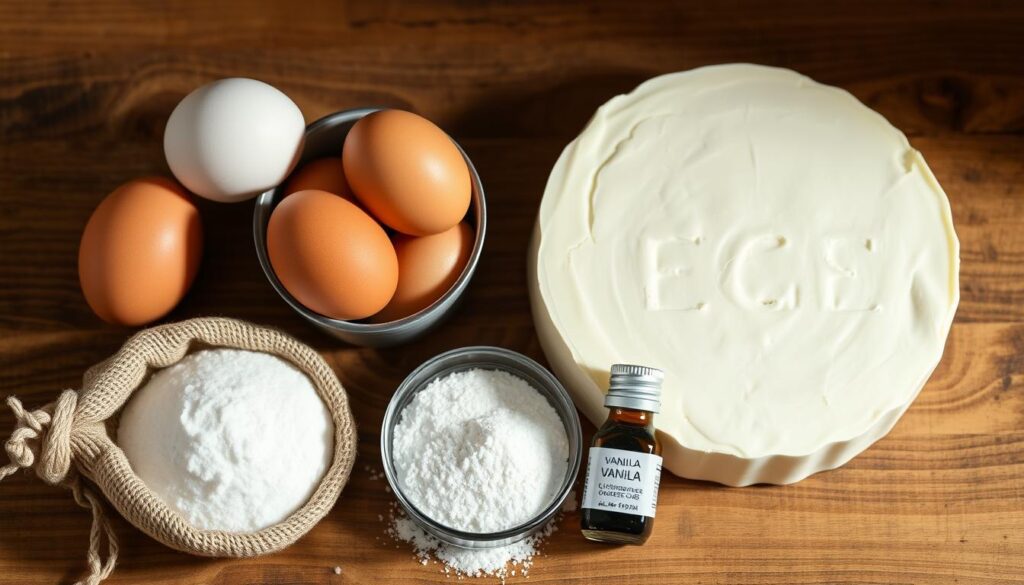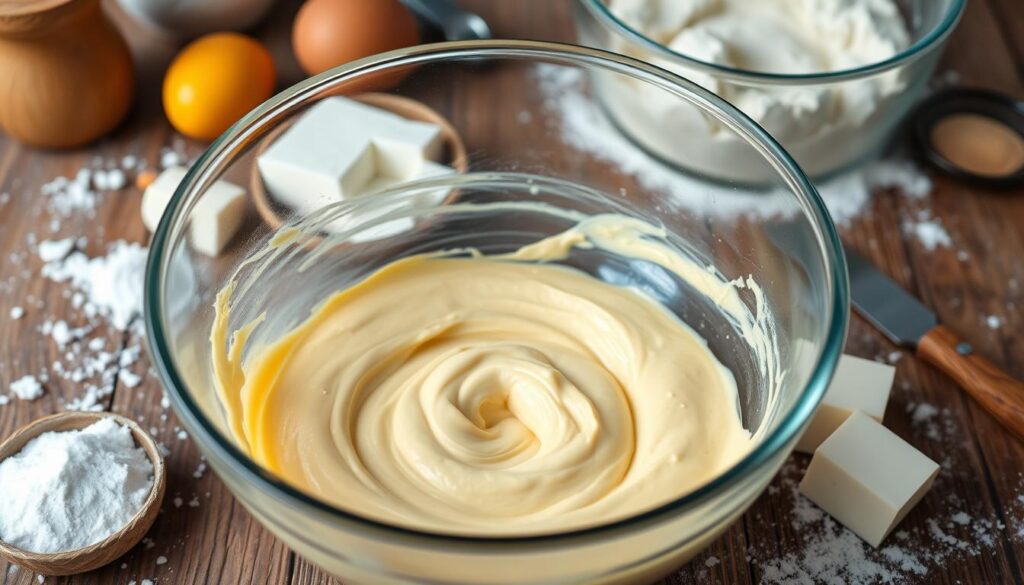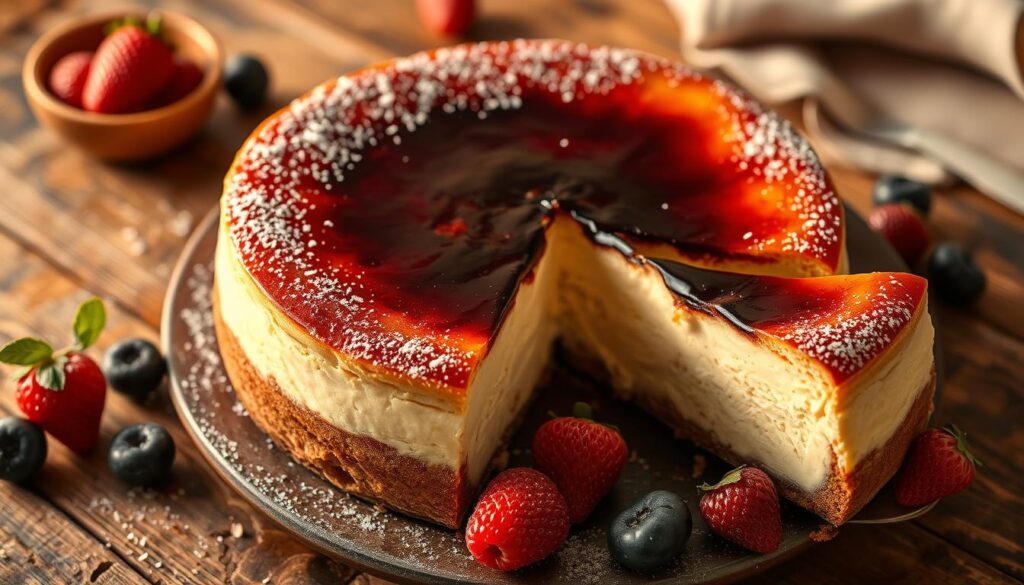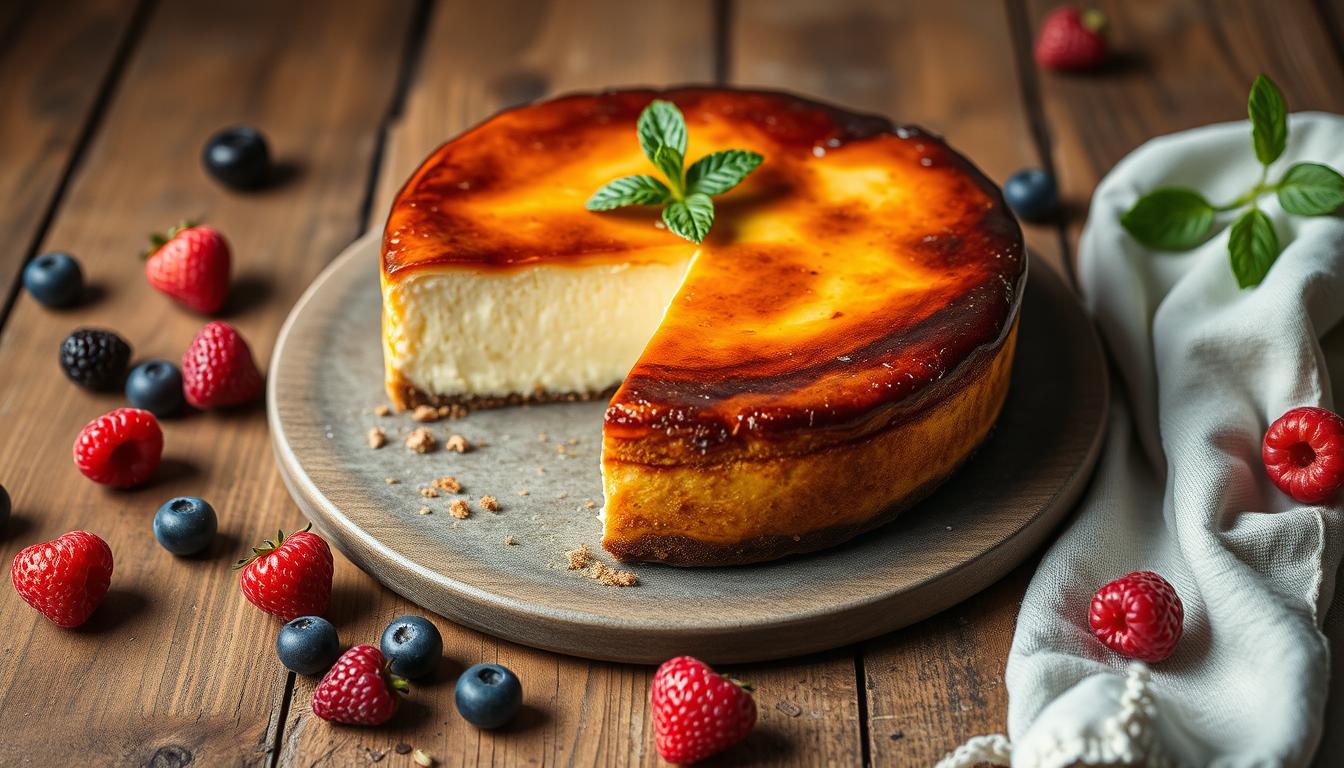The smell of a Basque burnt cheesecake baking is like a trip to Spain’s Basque Country. This dessert, known for its caramelized top and creamy inside, is loved everywhere. I’m excited to share a simple recipe to make this dessert at home.
Table of Contents
Key Takeaways
- Discover the origins of the beloved Basque burnt cheesecake from the renowned La Viña restaurant.
- Understand the unique characteristics that set this crustless cheesecake apart from traditional versions.
- Learn the art of intentionally burning the top to achieve the signature caramelized appearance and flavor.
- Gather the essential ingredients and kitchen tools required for baking the perfect Basque burnt cheesecake.
- Follow a step-by-step guide to master the mixing, baking, and cooling processes for a flawless result.
Introduction to the Iconic Spanish Dessert
The Basque burnt cheesecake comes from Spain’s Basque region. It has gained fame worldwide in recent years. This dessert, from La Viña in San Sebastian, has a charred top and a creamy inside.
Origins from La Viña Restaurant
In 1990, chef Santiago Rivera made the Basque burnt cheesecake at La Viña in San Sebastian. It’s different from American cheesecakes. It has a burnt top and a soft, creamy inside.
What Makes It Different from Traditional Cheesecake
The Basque burnt cheesecake is made differently than traditional cheesecakes. It has a charred outside and a creamy inside. This is because of how it’s baked.
The Art of Intentional Burning
The secret to the Basque burnt cheesecake is its baking. The high heat makes the top caramelized. This creates a sweet and burnt taste that’s loved by many.
“The Basque burnt cheesecake is a true testament to the culinary artistry of the Basque region, where chefs embrace the beauty of imperfection and celebrate the unexpected.”
Essential Ingredients for Basque Burnt Cheesecake
To make the perfect Basque Burnt Cheesecake, you need top-notch ingredients. The key is full-fat cream cheese, granulated sugar, and large eggs. Adding heavy cream and a bit of all-purpose flour makes it creamy and rich.
The recipe asks for 3¼ cups (750 g) of cream cheese, 1¼ cups (250 g) of sugar, 4 eggs, 1 cup (240 ml) of heavy cream, and ¼ cup (34 g) of flour. This mix is crucial for the cheesecake’s perfect taste.
It’s key to skip vanilla extract to let the cream cheese’s flavor stand out. Also, using less sugar balances the cheesecake’s caramelized and slightly bitter taste.
| Ingredient | Quantity |
|---|---|
| Cream cheese | 3¼ cups (750 g) |
| White sugar | 1¼ cups (250 g) |
| Eggs | 4 large |
| Heavy cream | 1 cup (240 ml) |
| All-purpose flour | ¼ cup (34 g) |
With these ingredients and the right amounts, you’re set to make a Basque Burnt Cheesecake. It will look amazing and taste incredible.

Required Kitchen Tools and Equipment
To make the perfect Basque Burnt Cheesecake, you’ll need some key tools. First, get an 8-inch or 9-inch springform pan. This pan lets the cheesecake rise and come out without breaking.
Next, line the pan with parchment paper. Make sure it goes up about 2 inches above the rim. This extra space helps the cheesecake rise during baking. Use two sheets of parchment paper to cover better and stop leaks.
Mixing Equipment Essentials
For mixing the batter, you can use an electric hand mixer or a stand mixer with a paddle. These mixers make sure all ingredients are well mixed. This leads to a smooth, creamy cheesecake.
Also, a digital scale is a must. It helps you measure ingredients like cream cheese and heavy cream accurately. These are key for the cheesecake’s perfect texture.
| Kitchen Tools | Recommended Specifications |
|---|---|
| Springform Pan | 8-inch or 9-inch |
| Parchment Paper | Two overlapping sheets |
| Mixing Equipment | Electric hand mixer or stand mixer with paddle attachment |
| Digital Scale | For precise ingredient measurements |
With these tools, you’re ready to make a beautifully baked Basque Burnt Cheesecake.
Preparing Your Kitchen for Success
Before starting the Basque Burnt Cheesecake, get your kitchen ready. Preheat your oven to 400°F (200°C) without the fan. This high heat is key for the burnt top that makes this dessert special.
Make sure your cream cheese, eggs, and heavy cream are at room temperature. This makes them mix well, creating a smooth batter. Take a moment to organize your ingredients, keeping everything you need within reach.
Butter your springform pan well and line it with parchment paper. This prevents sticking and gives the cheesecake its rustic look. Have a rubber spatula ready for mixing and scraping the bowl.
By preparing your kitchen and ingredients, you’re on the path to a great Basque Burnt Cheesecake. These simple steps make baking easier and let you focus on the unique burning process that makes this dessert stand out.
Step-by-Step Mixing Process
To make the perfect Basque burnt cheesecake, start with the right mixing. First, cream the room temperature cream cheese and sugar on a medium-low speed. This makes the batter light and airy.
Then, add the eggs one at a time. Mix on a low speed to fully mix each egg before adding the next. Slowly add the heavy cream while mixing. Finally, sift in the flour and salt, and gently fold them into the wet mixture.
Room Temperature Ingredients Tips
Make sure all ingredients are at room temperature before mixing. This makes mixing easier and the batter smoother. Cold ingredients can make the batter dense and uneven.
Proper Mixing Techniques
- Cream the cream cheese and sugar on medium-low speed until smooth and well-combined.
- Add the eggs one at a time, mixing on low speed to fully incorporate each one.
- Slowly stream in the heavy cream while mixing to ensure a homogeneous batter.
- Sift in the flour and salt, then gently fold the dry ingredients into the wet mixture.
- Avoid overmixing to prevent incorporating too much air, which can lead to cracking.
Achieving the Right Consistency
The batter should be smooth and pourable. It should flow easily but not too thin. This balance is crucial for the cheesecake’s signature jiggly texture.

Mastering the Baking Temperature and Time
To get the burnt yet creamy texture of Basque burnt cheesecake, you need to get the baking right. Preheat your oven to 400°F (200°C). Make sure it’s fully heated before putting in your cheesecake.
Bake for 60-65 minutes. High heat is key for that dark brown top. But watch it closely. If it’s getting too dark, cover it with foil.
It’s smart to use an oven thermometer for accurate temperature. Your oven’s thermostat might not be precise enough for this recipe.
The cheesecake is ready when the top is dark brown and the center jiggles a bit. This means it’s perfectly burnt outside and creamy inside.
| Ingredient | Amount |
|---|---|
| Cream Cheese | 450g (16 oz) |
| Sugar | 150g (¾ cup) |
| Eggs | 3 large |
| Cornstarch | 15g (2 tbsp) |
| Vanilla Bean Paste | 1 tsp |
| Heavy Cream | 180ml (¾ cup) |
By watching the baking time and high-temperature closely, you’ll make a perfect Basque burnt cheesecake.

Understanding the Perfect Wobble and Texture
As you wait for your Basque burnt cheesecake, knowing the perfect wobble and texture is key. The cheesecake is done when the edges are set but the center is still a bit jiggly and has a custard-like texture. It should be slightly underbaked for the best taste.
Signs of Doneness
Here are the signs to check if your Basque cheesecake is perfectly baked:
- The edges should be set and lightly browned, while the center remains slightly soft and jiggly.
- When gently shaken, the center of the cheesecake should have a subtle wobble, indicating it’s not fully set yet.
- The internal temperature of the cheesecake should register between 190°F to 200°F, higher than a typical cheesecake, resulting in the desired custard-like texture.
Cooling Process Guidelines
Proper cooling is key to get the right texture and avoid cracking. Follow these steps for the best results:
- Allow the cheesecake to cool to room temperature in the pan for about an hour.
- Then, refrigerate the cheesecake cooling for at least 4 hours or overnight to set completely before removing from the pan.
- The cheesecake can be stored in the fridge for 5 to 7 days, making it a perfect make-ahead dessert.
Mastering the perfect wobble and texture will reward you with a Basque burnt cheesecake. It will be irresistibly creamy, with caramelized edges and a luscious custard-like center.
Serving and Storage Recommendations
Once your Basque burnt cheesecake is ready, it’s time to enjoy its rich flavors. It’s best served at room temperature. This lets its creamy texture and caramelized top stand out. Some like it chilled for a cool contrast.
To serve, take the cheesecake out of the springform pan and remove the parchment paper. Cut it into big slices, showing off its signature wobble. Add fresh berries on top for color and flavor.
For leftover cheesecake, store it in an airtight container in the refrigerator for 1-2 days. Don’t freeze it, as it can ruin the creamy texture. When you’re ready, let the chilled slices come to room temperature for the best taste.
“The Basque burnt cheesecake is all about embracing its imperfections and celebrating the beauty in its rustic charm.”
Whether at room temperature or chilled, this Spanish treat will impress your guests. Enjoy each bite and let the creamy flavors melt in your mouth.
Conclusion
Basque burnt cheesecake is a unique, rustic dessert that’s surprisingly simple to make. Its burnt look and creamy inside offer a delightful contrast. This recipe lets bakers of all levels enjoy San Sebastian’s famous dessert at home.
The secret to making Basque burnt cheesecake is in its simple, precise steps. By following this guide, you can get the signature look and taste. It’s a must-try for impressing guests and satisfying your sweet tooth, whether you’re experienced or new to baking.
Let the Basque burnt cheesecake’s bold flavors and texture take you to Spain’s vibrant culinary scene. Enjoy this Spanish delicacy and its perfect mix of creamy richness and char. It’s a dessert that truly stands out.
FAQ
What is Basque burnt cheesecake?
Where did Basque burnt cheesecake originate?
How is Basque burnt cheesecake different from traditional cheesecake?
What gives Basque burnt cheesecake its unique texture and flavor?
What are the key ingredients for Basque burnt cheesecake?
What type of pan is best for baking Basque burnt cheesecake?
What equipment is needed for making Basque burnt cheesecake?
How should the ingredients be prepared for Basque burnt cheesecake?
What is the key to achieving the signature burnt top on Basque burnt cheesecake?
How should Basque burnt cheesecake be served and stored?
Source Links
- Easy Basque Burnt Cheesecake – https://www.spatuladesserts.com/easy-basque-burnt-cheesecake-recipe/
- Basque Cheesecake Recipe – https://www.spicebangla.com/basque-cheesecake-recipe/

